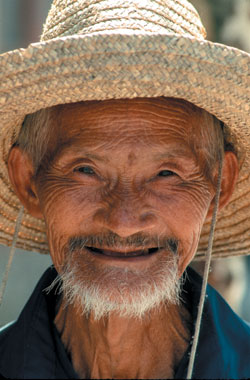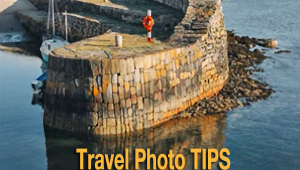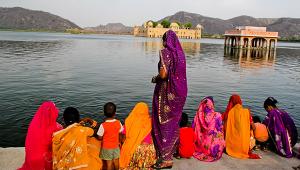Travel Photography in China
All Photos by Paul Elson
My images happened to be in the right place at the right time," says Paul Elson, a photographer who was invited to China by the Ministry of Cultural Affairs to lecture in Beijing after their delegates saw his work displayed in New York's SoHo district. Elson--who uses digital technology to create his own original works of art from his photos--attended a large photo exposition in the town of Duyan, China, in the summer of 2002.
 |
|
|
Of course, the trip also afforded great opportunities for photography. But rather than touring the countryside as part of a group, Elson was encouraged by his contact at the Ministry to seek photographic locations on his own. "An odyssey of indelible memories was the result," he says. He discovered that when he inquired where to shoot pictures, local people would send him to "spots suitable for typical postcard shots." As an alternative, he often hired a cab and found his own subjects. "I would choose my general direction from a map or by suggestions of the locals, but my course often becomes sidetracked by a route I happen upon that seems more interesting. Serendipity has made great contributions to my portfolio."
Timing is Everything
"I find dawn a magical time. Even in New York City, you can hear the birds at sunrise. I think it's the metaphor of everything starting anew. I find that I prefer the images I've captured early in the day, or at that time in the afternoon that I call `long shadows.'" He avoided both unflattering light and tourist traffic, he says, by not shooting during peak daylight hours. Elson looked for naturally misty scenes to photograph rather than to create them in Photoshop, although he altered a number of his images afterward to get them to look the way he wanted. One such scene, entitled "Li River Dawn," was an area not very close to his hotel. To get the shot, he woke up at 4 a.m., and took a cab to get to his destination by daybreak.
 |
|
|
Elson also believes strongly in scouting out photo spots ahead of time. "When you find a scene that you like, go back at an optimum time to shoot it," he says, although he adds that this doesn't always guarantee fabulous results. "When I find something I like, I always have to remind myself not to seek that `maybe even more beautiful' shot down the road--to work on this shot, and get that `maybe' shot tomorrow."
"You don't just `take' photos, you `make' them," he asserts. He waits for good light and sometimes adds and subtracts elements later in Photoshop. Yet, in addition to his artistic images created via Painter or Photoshop, he's done some wonderful "straight" photography.
"As photographers, we're looking for metaphors--we try to capture something in which the viewer immediately knows what we're trying to say at a glance. The best images communicate instantly, no caption required. I find it very pleasing when I create an image, that someone tells me it expresses something, perhaps nondefinable, that they wish to keep--an emotion, a memory, something that might have been--that's what art is all about." In Elson's case, he discovered that he liked photographing scenes that depict time-honored Chinese traditions.
 |
|
|
Creating Images
He also stresses that simplicity is key. "Less is more--it's easy to say, but not always easy to do. I know that I can make a good image if I can visualize it first." One such image is "Tai Chi," which Elson photographed at a boat landing at dawn. The original scene included elements that he found extraneous, such as numerous people participating in the Chinese discipline Tai Chi, others looking on, and several industrial-looking boats. Later in Photoshop, he removed the distracting objects and pared the composition down to the single man in a Tai Chi pose, which is a simpler, more striking image. "It's the beauty of using Painter or Photoshop. My best shots are ones that I pre-visualize or a scene that inspires me."
















































